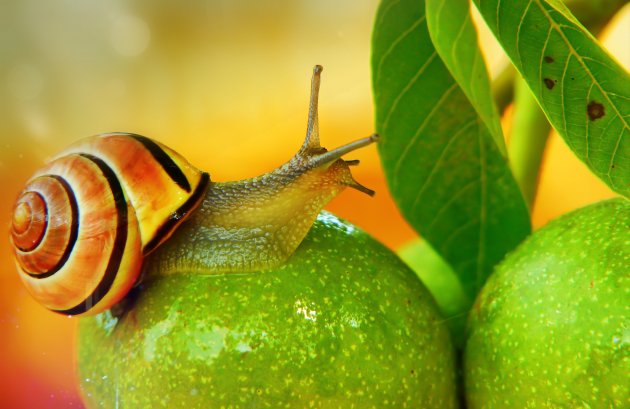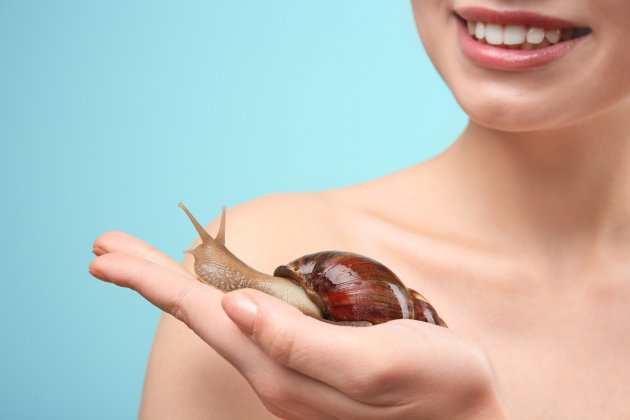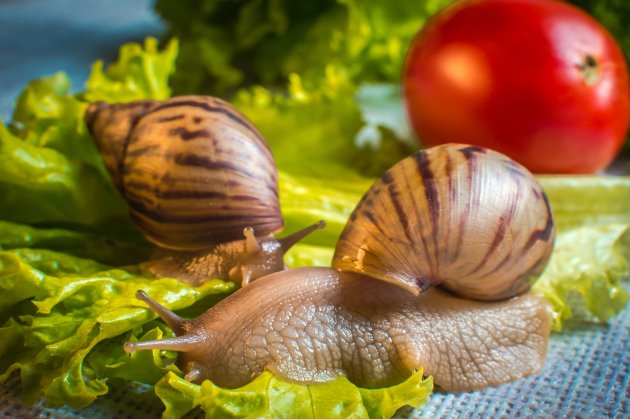The world of keeping critters as pets has been a favorite past time for centuries. If we can pet it, play with it, watch it, enjoy and love it, we will consider it a pet. However, gone are the days where we keep only dogs, cats, birds, and the occasional rodent for our companions. Today, pets come in all different shapes, sizes, and species, including the snail.
How do you keep a snail as a pet? Read on for some important tips on keeping a land snail happy and healthy. Plus, we’ll also astound you with some fun facts on this slimy "slug."

The Appearance of the Pet Snail
The Garden Snail is the one most commonly kept as a pet. This critter is scientifically considered a “terrestrial gastropod mollusk.” It is native to Europe but also lives in many other areas around the world.
This species of snail has a brownish body, soft, and covered with a slimy coating (mucus). The shell has spirals and is yellow to cream in color with brown “spiral” stripes. The sphere-shaped shell measures up to 1.3 inches high by 1.5 inches wide, with a slightly rough texture and with four or five spirals.
Garden snails move by producing a slimy mucus (a.k.a. the snail trail) which reduces the friction between its soft body and the traveling surface. It also uses a large muscular “foot” that helps propel it forward.
The garden snail also has four tentacles; two smalls ones are used for smelling and feeling, while the two longer ones contain its eyes. Even though the snail’s eyes stick out on these stalks, its sight is weak - it can only determine between light and dark.
Can You Keep a Snail as a Pet?
The land garden snail makes an excellent pet for children, classrooms, or folks that want a low-maintenance and quiet housemate. This species of snail is readily available through pet retailers or your own backyard. However, taking an animal out of its natural habitat is not recommended, as they can succumb to stress, or illness because their living conditions are not close enough to their natural surroundings.
The Giant African Land Snail has also been put into the pet trade. But due to their invasive nature, the species has been outlawed in many states and countries.
Garden Snail Behavior
The garden snail lives its life on the land and, in the wild, prefers the rainy weather over dry periods. It is nocturnal, so expect your snaily-friend to be most active during the night time and early morning hours.
Extremely dry conditions will have your snail retreating into its shell and covering the opening with “epiphragm” or a slimy mucus. This protects the snail from drying out and from predators.
Of course, it will come as no surprise to you that the snail is slow, moving an only ½ inch every second.

How Do You House a Pet Snail?
To house a pet snail, you will need a plastic container or a glass aquarium with a secure lid, so your new pet doesn’t escape and gets lost. If you plan on housing a snail as a pet, then the bigger the enclosure, the better.
On the bottom of its home, it will need a substrate in the form of clean, pesticide-free soil (purchase from a retailer) with a depth of 1 to 2 inches. You may also want to add sphagnum moss and loose leaves like dandelion for munching on and for hiding under.
In nature, snails spend much of their time out of sight from predators, so providing your new pet with objects like terra cotta pots, sticks, smooth rocks or small potted plants will make it happy.
Tips on Keeping a Pet Snail
Like all the pets we have in our homes, there are some tips to help keep your snail happy and healthy.
Tip #1 - As we discovered earlier, snails like to be moist (overly dry conditions will force your snail to seal itself into its shell). Use a spray bottle to mist your aquarium daily, making it damp, but not too wet.
Tip #2 - Avoid using substrates like rocks, pebbles, shells, or that which is brittle. Snails like to burrow into the “ground” so these will not be suitable.
Tip #3 - Snails are social creatures that enjoy the company of other snails. Be sure to keep them (in at least) pairs.
Tip #4 - Do not mix species of snails as they may carry different pests or even diseases that can harm each other.
Tip #5 - Be sure your snail's habitat has proper and adequate ventilation.
Tip #6 - Always thoroughly wash the container and any objects you provide your pet snail with to ensure there are no pesticides or detergents on the surfaces (these can kill your pet snail).
Tip #7 - Snails like an ambient temperature from 65 to 86 degrees Fahrenheit. If your home is cooler than this, you may have to provide your pet snail with a heating pad for under the enclosure.

Feeding Your Pet Snail
Land snails enjoy a wide variety of food, so try the following to see what your little critter likes;
- Mushrooms
- Apples
- Tomatoes
- Leafy greens
- Bananas
- Carrots
- Strawberries
Commercial turtle food is also recommended as are small bits of wet or dry dog and cat treats. Always wash your snail's food before serving and place it in a shallow dish. Remove and replace any uneaten leftovers before it spoils.
Note: Never feed your pet snail salty snacks as it can kill it.
A small shallow dish of water should also be provided to your pet snail. This will quench its thirst, as well as help keep humidity in the enclosure.
Snails Also Need Calcium
Snails need calcium to keep their shells strong and beautiful. You can add calcium to your snail's diet through a cuttlefish bone. This product can be purchased at pet retailers in the bird section.
Wash and dry the cuttlebone before placing it in your snail's enclosure. Snails can absorb calcium through their skin, so you may see your little pet sitting on the cuttlebone when it needs a boost of this mineral.
Handling Your Pet Snail
When it's time to clean your snail's enclosure, you will need to remove it. If your snail is on the side of the tank, wet your hands and mist the snail with water. Now gently slide your finger under the snail's head (between the snail and the enclosure wall). Take your other hand and very gently and carefully support your snail's shell while sliding your finger under its body. Once your snail has released itself from the tank, place it in another enclosure to clean its tank.
Note: Never yank on your pet snail, as this can cause it great harm.
Fun Snail Facts
Want to learn more about the garden snail? Check out these fun facts!
- This snail breathes air and only has one lung!
- Snails without shells are called “slugs.”
- The snail’s slime trail also allows this creature to move upside down.
- With the proper care, this snail can live up to 25 years.
- The garden snail is edible, but it is not the “escargot” variety.
- The snail is one of the slowest creatures on earth.
- The garden snail is considered a pest by farmers as it eats the stems and leaves of many crops.
Snails & You
The garden snail can be a great pet. It is clean, quiet, and never has to be walked. If you would like to keep a garden snail as a pet, do your research to be sure you are ready for the responsibility of snail keeping. Even though it is small, it is still a living creature that depends on you for all its needs. Give it the best life possible!
References and further reading:
- Barrie Watts,1898,Keeping Mini Beasts: Snails and Slugs (Buy Book)
- Joseph Dunbury,2017,Giant African Land Snails as pets (Buy Book)
- BBC, A snail is the perfect pet
- iucngisd.org, Giant African Snail